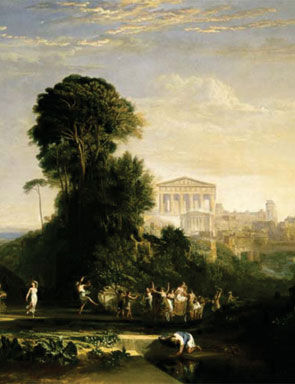Sotheby’s New York will offer "The Temple of Jupiter Panellenius" by William Turner
Joseph Mallord William Turner, The Temple of Jupiter Panellenius. Estimate: $12/16 million. Photo: Sotheby's
NEW YORK, NY.- On January 29, 2009, Sotheby’s New York will offer a magnificent work by Joseph Mallord William Turner, The Temple of Jupiter Panellenius – one of the most important oil paintings by the artist remaining in private hands. The work, estimated to bring $12/16 million, has been in the private collection of prominent fine art dealer Richard L. Feigen for over twenty-five years, and was a highlight of the retrospective of the work of JMW Turner RA presented in 2008 by The Metropolitan Museum of Art in New York, The National Gallery of Art in Washington, D.C., and the Dallas Museum of Art. The Temple of Jupiter Panellenius, will be on view at Sotheby’s New York October 29 through November 3, followed by exhibitions in London, Paris and Los Angeles.
George Wachter, Vice Chairman and Co-Chairman of Sotheby’s Old Master Paintings Department Worldwide said, “This work is one of the most significant paintings by Turner to come on to the market in many years. It is remarkable not only for its magnificent beauty, but also for its scale, fantastic state of presentation and distinguished history. Here, Turner takes inspiration from Claude, but makes his own statement on the times Europe was enjoying – free from Napoleon’s domination.”
The Temple of Jupiter Panellenius is one of only three oil landscapes concerned with ancient Greece painted by Turner, and is one of less than twenty significant paintings by the artist still held in private hands. First exhibited in 1816, when Turner was at the height of his popularity as a British landscape painter, the canvas was paired with an early 19th century depiction of the same scene illustrating the temple in ruin and was received with great acclaim. In this painting Turner skillfully indulges his passion for painting landscapes enlivened with historical significance. The picture depicts figures rejoicing in the foreground against a rising sun and the Temple to Jupiter Panellenius – approximately translated as Jupiter the God of all Greeks and located on the island of Aegina. Jupiter was also known as the bringer of light and the patron of communal life, and in the sunlight-infused picture Turner depicts a romanticized vision of dawn enveloping an ancient, heroic and free civilization.
The painting is however more than a simple homage to ancient Greek civilization, which Turner thought to be “the most brilliant period of human nature,” and marks the beginning of the artist’s depictions of the rise and fall of civilization which would dominate his work for the next twenty years. The canvas also touches on poignant issues of the period in which it was completed. Turner painted during a time of heightened sensitivity to the protection of ancient Greek artifacts and supported his contemporaries’ efforts to establish a permanent safe home for such works. In the glowing depiction of the temple’s original condition, paired with the temple’s modern ruin, he drew attention to the need to protect ancient art and natural beauty from decay and foreign invasion. Additionally, at the time the canvas was completed, Greece was occupied by the Turkish Empire. In this picture, Turner paints the figures dancing a Greek national dance known as the “Romaika”, which is repeated in the pendant painting to demonstrate the strength and solidarity of Greek national customs. Turner had witnessed similar oppression and subsequent liberation of cultures in the wake of the Napoleonic occupation of Europe, and therefore painted in 1816 with moving nostalgia before an audience that had experienced the same.
The Temple of Jupiter Panellenius was acquired from the artist for a substantial sum by the London publishing company Messrs Hurst, Robinson & Co in 1823. Just three years later, when the company faltered, both the business and the painting were acquired by the young and talented Henry Graves, who would go on to be appointed ‘Her Majesty’s printsellers and publishers in Ordinary.’ In 1836, Graves sold the painting to Wynne Ellis, an entrepreneur who created the largest silk business in London. He was a passionate collector and the present work was the star of his collection. Late in life, Ellis sold ninety-four Dutch and Flemish Old Masters from his collection to the National Gallery in London, and following his death, the remaining paintings were sold at auction. The Temple of Jupiter Panellenius, was purchased at that sale by the dealer Goupil for his most important client Antony Gibbs, for the staggering sum of 2,000 guineas. The painting was inherited by Gibbs’ son, Lord Wraxall and descended in his family to the second Lord Wraxall, who sold it in 1982, when it was purchased by the present owner, Richard L Feigen.

/https%3A%2F%2Fprofilepics.canalblog.com%2Fprofilepics%2F1%2F0%2F100183.jpg)
/https%3A%2F%2Fstorage.canalblog.com%2F03%2F02%2F119589%2F96711876_o.jpg)
/https%3A%2F%2Fstorage.canalblog.com%2F11%2F31%2F119589%2F94773502_o.jpg)
/https%3A%2F%2Fstorage.canalblog.com%2F20%2F83%2F119589%2F94772815_o.jpg)
/https%3A%2F%2Fstorage.canalblog.com%2F26%2F72%2F119589%2F75604929_o.jpg)
/https%3A%2F%2Fstorage.canalblog.com%2F59%2F60%2F119589%2F26458628_o.jpg)



/http%3A%2F%2Fstorage.canalblog.com%2F33%2F69%2F119589%2F110383716_o.jpg)
/http%3A%2F%2Fstorage.canalblog.com%2F70%2F78%2F119589%2F33073701_o.jpg)
/http%3A%2F%2Fstorage.canalblog.com%2F93%2F18%2F119589%2F30611657_o.jpg)
/image%2F1371349%2F20240418%2Fob_ac5c4c_telechargement.jpg)